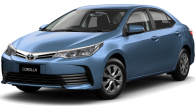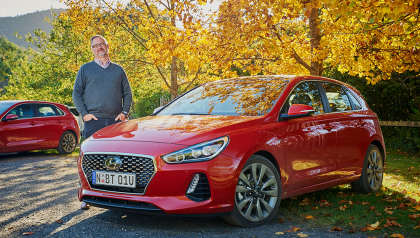For over a decade, the Mazda3 has been part of a three-way battle for supremacy in the Australian small car market. The 2004 original threw the felines among the flying rats when launched, transforming the then-dowdy 323 into a stylish, well-equipped, and well-priced contender for Toyota's segment-dominating Corolla, and later, Hyundai's value-packed i30.
In 2017, the battle is still raging. Late 2016 saw a mild update to Mazda's flagship hatch and sedan range to add a few bits and bobs to the its already finely-judged specification. The Corolla stayed pretty much the same, and just this month Hyundai dropped what is now an annual tradition, an absolute cracker of a new car. This time, the all-new i30.
As you can see, Mazda has never had it easy, and it's a testament to the 3's quality, style and ever-growing reputation that it continues to hold its own in the top three.
Mazda 3 2017: Touring
| Engine Type | Inline 4, 2.0L |
|---|---|
| Fuel Type | Unleaded Petrol |
| Fuel Efficiency | 5.7L/100km (combined) |
| Seating | 5 |
| Price From | $12,760 - $16,940 |
| Safety Rating |
|
Is there anything interesting about its design?
8 / 10
The 3's third iteration is sleek and fluid, as befits Mazda's successful 'Kodo' design language. In both sedan and hatch, it looks low, sleek and classy. Whether rolling on 16 or 18-inch rims, the car has a good road presence and there isn't a bad angle on it.
The hatch is arguably less-balanced, in profile at least, its shorter exterior dimensions obvious in photos. The choice is between which you prefer for style and/or boot size.
.jpg)
The cabin is equally nice to look at - Mazda interiors continue to impress. Materials feel good and even the cloth trim is nicely textured to make you feel like you haven't cheaped out when going lower in the range.
The only real complaint is that on some models, it's very dark as the plastics are all dark grey or black with little to break up the expanses of... well... black and grey. The interior photos tell the story, although some models feature flashes of colour to lift the mood.
We're often asked "Where is the Mazda3 built?" and we can tell you it's at Mazda's Hiroshima plant in southern Japan.
How practical is the space inside?
7 / 10
The 3 has grown over the years, with the sedan measuring 4.6m long, 1.8m wide and 1.45m high.
With the boot of the sedan lopped off and replaced with a hatchback, the 3 is 110mm shorter, which translates to a much smaller cargo area. The hatch can carry a still-reasonable 308 litres of stuff when full, while the boot swallows another 100 litres exactly. The hatch stands slightly higher at 1.47m high but is the same width as the sedan.
There's little choose in the cabin as it is basically, riding as it does on the same length wheelbase (2700mm), meaning virtually identical interior dimensions. There is plenty of room for four adults, offering good rear legroom for even those over 183cm (six feet) - I've had a 3 with four adults in it, with no (real) complaints or issues from the back seat passengers.
.jpg)
If you want a cup holder, the 3 has two up front and two in the rear, with bottle holders in each door as backups. Some models feature seat back pockets where you can store the kids' gadgets while in transit.
It's an easy car to park in either hatch or sedan, which is lucky because park assist is limited to front and rear parking sensors and no auto-parking as on some rivals.
Ground clearance when unladen is 160mm, so lumps and bumps won't turn into scrapes. Kerb weights range from 1258kg for a Mazda 3 manual Neo to 1336kg for an auto Astina. Gross vehicle mass ranges from 1800kg to 1875kg.
Dealer accessories for organising your stuff include a cargo tray which also acts as a boot liner. You can also twist your dealer's arm to throw in floor mats on Neo, Maxx and Touring - they're standard on SP25 and up.
Does it represent good value for the price? What features does it come with?
7 / 10
How much is a Mazda 3? As ever, it depends on what you're after and if the drive-away price suits your budget.
The range used to require a huge map to navigate, but as better standard equipment levels have found their way into the range, particularly when it comes to safety, it's become a little easier to conduct a comparison in the comfort of your own home. There are still plenty to choose from, though. With a price list that stretches from under $21,000 to just over $35,000, there are 24 distinct models, and six trim levels.
The 3's basic mechanical package covers the Neo, Maxx and Touring, with a naturally aspirated 'Skyactiv' 2.0-litre, four cylinder petrol engine and a choice of six-speed auto or manual, while the SP25s are propelled by a 2.5-litre petrol four.
All the way through the price range, you can have a manual or for an extra $2000 cost, the six-speed automatic. Hatch and sedan are identically priced and specified. Drive-away pricing is not uncommon and in many cases listed on the Mazda website.
Starting with colours, boy are they cheap. Black, 'Deep Blue Mica', 'Eternal Blue Mica', 'Titanium Flash' (bronze), silver and white are all free, metallic or not. Mazda's signature 'Soul Red' and 'Machine Grey' colours are a still-reasonable $300 rrp (or MLP as the manufacturers prefer). Sadly, the green and purple shades from previous iterations are no longer available.
.jpg)
Most notable is the inclusion of low-speed forward auto emergency braking on all Mazda 3 models, which the company calls 'Smart City Brake Support'. Also worth noting that every 3 from the Maxx up features a reversing camera, blind spot monitoring and reverse cross traffic alert. Few cars at this level have such a long list of safety features.
The range opens with the Neo hatch and sedan, priced from $20,490 to $22,490. Like its 2 and CX-3 Neo brethren, the standard features list is basic but useful, as long as you can go without some treats like a reverse camera and Mazda's MZD Connect touchscreen media system. The startlingly low price (especially for the roomy and big-booted sedan) comes with cloth trim, cruise control, air conditioning, 16-inch alloy wheels, a four-speaker stereo, keyless entry and start, power windows, power folding mirrors and a space saver spare tyre.
Even down here in the cheap seats you'll get an MP3 player and CD player for your choice of sound source.
The Maxx builds on the Neo's specification, priced between $22,890 and $24,890. You get a different alloy wheel design, two more speakers for a total of six, blind spot monitoring, reversing camera, reverse AEB, reverse cross traffic alert, sat nav, LED fog lamps, leather bits (including gearknob, handbrake and steering wheel), digital DAB radio and upgraded interior lighting.
The Maxx introduces the 'MZD Connect' multimedia system which also includes GPS and reversing camera. A 7.0-inch screen is perched on the dashboard and acts as a touchscreen when you're stationary. On the move, you can use the easily-memorised console-mounted rotary dial.
Despite missing out on Apple CarPlay for iPhone and Android Auto, the system is intuitive, simple to use and almost sorts out the mess that is digital radio station selection. It's a good system and stands out from its Japanese competition for ease of use and excellent presentation.
MZD Connect also offers Pandora, Stitcher and aha app access. Smartphone connectivity is either via Bluetooth or two USB ports.
The 3 was the first model to feature Mazda's 'G-Vectoring' technology which helps sharpen up the steering during cornering.
Next up is the Touring, priced from $25,290 to $27,290, the difference as always being your choice of transmission. The Touring picks up dual zone climate control, auto headlights and wipers, leather seats and an electric parking brake.
The SP25 heralds the only increase in engine size, the 2.5-litre SkyActiv engine which comes with higher power and torque specs but the same choice of six-speed manual or automatic, for $25,690 and $27,690 respectively. The SP25 not only has a bigger set of wheels (18-inches) it also has electro-chromatic rear vision mirrors and dual-zone climate control, but goes back to cloth trim.
The SP25 GT is a big jump, with prices starting at $29,990 for the manual gearbox and $31,990 for the auto. The price increase comes with a decent specification bump which includes adaptive LED headlights, tail-lights and fog lights, leather trim, powered and heated front seats, head-up display and traffic sign recognition. Engine specs remain unchanged from the 'base' SP25. The sound system is also upgraded to nine Bose-branded speakers.
The final model in the line-up is the SP25 Astina, priced between $33,490 and $35,490. Added to the GT's spec is active radar cruise control and a glass sunroof.
None of the range features a full size spare.
For a detailed model comparison, check out our snapshots which list the trim levels in full.
What are the key stats for the engine and transmission?
8 / 10
The Mazda3 range is available with two transmissions and two engines. Since the demise of the MPS3, there is no AWD turbo version and with the departure of the XD, diesel problems are nothing to worry about. There has never been a factory LPG option.
The 2.0-litre SkyActiv-branded engine produces 114kW/200Nm.
SP25 models run the 2.5-litre SkyActiv, with 138kW/250Nm, a useful increase in horsepower.
The 3 features stop-start with the manual transmission and the auto, and the 3 was the first model to feature Mazda's 'G-Vectoring' technology which helps sharpen up the steering during cornering.
.jpg)
For those keen on load capacity ratings for towing, the 3 is rated at 1200kg braked and 600kg unbraked. Towing capacity is the same for all engine and transmission combinations.
Both run on standard unleaded, use a standard oil type. Oil capacity is model dependent, and can be found in the owners manual.
A regular question is whether the 3 makes use of a timing belt or chain - we can report the SkyActiv engines are both chain-driven.
Performance figures vary between the two engines - the SP25 auto should complete the 0-100km/h dash in just under eight seconds with the 2.0 cracking it in around nine seconds.
How much fuel does it consume?
7 / 10
Mazda claims the 2.0-litre will return 5.3L/100km on the combined cycle for the manual and 5.0L/100km for the automatic. For the 2.5-litre, the official combined cycle figure is 6.5L/100km for the manual and 6.1L/100km for the auto.
Fuel tank capacity is 51 litres.
Recent Mazda3 reviews for CarsGuide reveal varying mileage figures. I drove the 3 Touring and got 8.0L/100km and when I drove the Neo saw an indicated 8.2L/100km, so you'll get around 600km to a tank with the 2.0-litre petrol motor.
In the 2.5-litre SP25, Richard Berry did not spare the road and returned 11.1L/100km, suggesting a range of under 500km if you're having fun. Calm down and you should get reasonable fuel economy from the 2.5, if still closer to 9.0L/100km than the claimed figure.
What's it like to drive?
8 / 10
Whether in 2.0 or 2.5-litre form, the current 3 is by far the best. Mazda's engineers have paid close attention to complaints that dogged earlier 3s, including road noise and a lack of front grip. Both of these have largely been banished, with the teams delivering a well-balanced chassis that rides and handles well.
The 3 is front-wheel drive, but with no torque steer, it's an easy companion in the wet or the dry, with well-tuned stability and traction control systems keeping things in check. It's been a long time since a Mazda hatchback was rear-wheel drive.
There is still some less than pleasant noise under hard acceleration, but it's much quieter than before.
Part of the credit for the car's transformation goes to some more sensible use of sound-deadening to simply block the noise, but also in tweaks to the shell and the suspension itself. There is still some less than pleasant noise under hard acceleration, but it's much quieter than before.
Added to that was last year's update with G Vectoring, a system that helps smooth out direction changes by adjusting the torque across the front axle. It makes the 3 feel rather pointier than in years gone by while boosting driver confidence. It's subtle, but effective and feels a lot more expensive than it is.
Front suspension is by MacPherson struts and rear suspension is a multi-link setup that is slowly becoming the segment standard. The turning circle is a commendably tight 10.6 metres.
Given the 3 doesn't have a 4WD version or even reasonable ground clearance, its off road ability is somewhat limited.
Warranty & Safety Rating
What safety equipment is fitted? What safety rating?
8 / 10
All 3s feature the same airbag count - six. They also feature a minimum safety package of ABS, stability and traction controls and forward AEB.
The Maxx adds reversing camera, blind spot monitoring, reverse AEB and reverse cross traffic alert.
The SP25 GT adds driver attention detection and traffic sign recognition to help you keep abreast of speed limit change.
Baby seat anchorages come in the form of three top-tether points and two ISOFIX points.
The entire range carries a five-star ANCAP safety rating.
What does it cost to own? What warranty is offered?
7 / 10
Mazda's standard warranty runs for three years/unlimited kilometres and roadside assist starts at $68.10 per year or $83.50 for a few more inclusions. There is no indication of an extended warranty sold by Mazda, but a dealer will no doubt try and flog you a third-party offering.
Service costs are capped for the first five services. Visits to the dealer come every 10,000km or 12 months, whichever comes first. Service costs alternate between $297 and $324 for a total cost of $1539 for the five.
There are extras, such as cabin air filter ($64), and if you need oil, Mazda will charge a very reasonable $15. It's worth noting Hyundai's capped price servicing regime applies to the lifetime of the car.
If past models are anything to go by, durability shouldn't be an issue. The roads are still crawling with first-gen 3s.
Reliability faults seem few and far between, with no widespread reported transmission problems, gearbox problems or issues with oil consumption.
If past models are anything to go by, durability shouldn't be an issue. The roads are still crawling with first-gen 3s. For common faults, check our Mazda3 problems page for an idea of its general reliability rating.
The 3 enjoys good resale value, with a check of the price guide suggesting a 2014 Neo will fetch between 65 and 75 per cent on a private sale, suggesting few issues when you need to shift a second hand machine. Dealer trade-ins will yield around 51 and 60 percent of the new car price of $22,490.
Verdict
The 3 is a car that will satisfy growing families, couples or a sole driver who likes a bit of space or a bit of metal around them. While the Neo is a bargain basement starter, competition around that price point comes thick and fast from Japanese and Korean rivals, with Euros not far behind in the form of VW and Skoda. Like I said, it's a tough market.
The pick of the bunch is the Maxx, with all of the good safety gear and an options list so short it's not worth bothering with. The rest of the range features largely cosmetic bits and pieces that are perfectly fine but not fundamental to the experience.
Is the Mazda3 your pick or is Hyundai's new i30 or Toyota's venerable Corolla your small car thing? Or are you contrary and like a bit of Euro in your hatch? Tell us what you think in the comments below.
Pricing Guides






.jpg)

.jpg)
.jpg)
.jpg)
.jpg)

.jpg)

.jpg)













.png)

.jpg)



